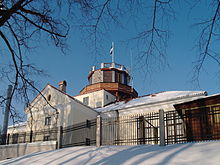Dorpat observatory
| Dorpat observatory | |
|---|---|
| Consist | 1811–1963 (on site, since then in Nõo ) |
| IAU code | 075 |
| Type | Observatory |
| Coordinates | 58 ° 22 '47 " N , 26 ° 43' 18" E |
| place | Tartu (Dorpat / Derpt / Jurjew) |
| operator | University of Dorpat (until 1946) |
The Dorpat observatory (Estonian Tartu Observatoorium , Russian Tartuskaja / Jurjewskaja observatorija ) is a historical astronomical research facility in Tartu (German Dorpat, Russian Дерпт, Derpt until 1893, Jurjew until 1917) in today's Estonia (formerly Russia ).
The observatory is located at the foot of the former Domberg. The Russian main observatory in Pulkowo, founded in 1839, is only 250 km to the northeast - a short distance for Russia .
It was built in 1811 at the German University of Dorpat and was the place of work for important astronomers . The Dorpater observatory soon became internationally known, among other things for the large refractor designed by Josef Fraunhofer - the first pure color telescope with an objective of almost 25 cm aperture. By 1900 all eight directors came from Germany. To be highlighted are Friedrich Wilhelm Struve , his son Otto Wilhelm Struve and Johann Heinrich Mädler, who is known for his moon atlases .
history
In 1811 an observatory was opened at the German-speaking Imperial University of Dorpat on Toomemägi , the city mountain of Tartu. It was founded by the mathematics professor Wilhelm Andreas Pfaff (1774-1835), who, however, moved to Nuremberg in 1809. The first director of the observatory was Johann Sigismund Huth (1763-1818).
After Huth's death in 1818, Friedrich Georg Wilhelm Struve was appointed professor of astronomy at the University of Dorpat, who had studied and obtained his doctorate here. In 1820 he took over the post of director of the observatory. Under his leadership, Dorpat soon became one of the leading astronomical institutions.
In 1824 a very powerful refractor from the workshop of Josef Fraunhofer was put into operation, which with a 24.4 cm aperture and a focal length of 4.33 m was the largest pure color telescope of this time. In the following years Struve carried out extensive studies on binary stars , which he published in two volumes. He was also responsible for special tasks in Russian national surveying , including a. he planned the almost 3,000 km long Struve Arch named after him . In 1839 Wilhelm Struve moved to the newly established Pulkowo observatory near St. Petersburg.
In 1840 Johann Heinrich von Mädler took over the management. He continued Struve's work, determined the exact position of stars ( astrometry ) and made detailed drawings of the moon , which brought Mädler lasting fame. In 1865 he resigned for health reasons. His successors were Thomas Clausen (from 1865 to 1872) and Peter Carl Ludwig Schwarz (1872-1894).
From 1873 to 1876, the mathematician and geodesist Heinrich Bruns worked in Dorpat, and from 1880 to 1894 Ludwig von Struve (a grandson of Friedrich Georg Wilhelm Struve).
Over time, Dorpat lost its importance as other observatories had larger instruments. Later heads of the observatory were Grigory Lewitsky (1894-1908), Konstantin Pokrovsky (1908-1918) and Taavet Rootsmäe (1919-1948).
In 1917 Estonia became independent and Dorpat was renamed Tartu . After the Second World War , the university's institutes were reorganized and it was decided to build a new observatory, the Tartu Observatoorium . After completion in 1964, the scientists moved.
In 1996 the old observatory was transferred back to the university. After temporarily using it as an office space, the decision was made in 2004 to convert it into a museum. The Dorpat observatory was restored from 2009 to 2011 and the museum opened in April 2011.
The observatory is designated as a national cultural monument and belongs to the astronomical world cultural heritage Struve-Bogen . Because of its importance in the history of astronomy, it has been declared an Outstanding Astronomical Heritage by the International Astronomical Union .
Furnishing
When it opened, the Dorpat observatory had a reflector telescope made by Wilhelm Herschel and an achromatic lens telescope from Trotztop with a focal length of 1.5 m.
In 1814 a meridian telescope was obtained from George Dollond , in 1822 a meridional telescope from Reichenbach's famous Munich workshop ( Mathematical-Precision Mechanical Institute ) followed, and in 1824 the large Fraunhofer refractor from 1824 from the same workshop.
It has an aperture of 9 German inches (244 mm) and a focal length of 13 feet (4.33 m). It was the largest lens that Fraunhofer has ever made - it was with it that the development of the so-called giant telescope and the precise exploration of double stars began . Thanks to Fraunhofer's newly developed position micrometer , Struve was able to publish a catalog with 3112 precisely measured double stars, the Catalogus novus stellarum duplicium from 1827. The refractor was restored in 1993.
In 1873 a heliometer was acquired - a telescope with a double lens for measuring the smallest angle differences - and in 1897 a zenith telescope from the Hamburg company A. Repsold & Sons .
In 1911, a 20 cm refractor from Carl Zeiss with a 3 m focal length was put into operation. In the same year, a Petzval astrograph with 15 cm aperture and 78 cm focal length was installed to carry out astrophotography .
Web links
- The observatory website (English)
Individual evidence
- ^ The History of the Old Observatory. Old Observatory, The University of Tartu Museum (English, Estonian).


